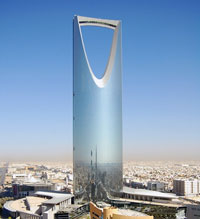| Posted: Nov 22, 2012 | |
Nanotechnology windows generate electricity from outside heat |
|
| (Nanowerk Spotlight) Increasingly we are observing glass windows as a key building material in modern construction design. Specially in the urban areas presence of high rise residential and commercial buildings are clearly visible. At the same time, it is important to make this increasing urbanization as green – i.e. environmentally benign – as possible. With an increase in building height, its power consumption rises not only because of the presence of more people but also because lifting water, operating elevators, lighting common spaces etc. require extra amounts of power. Therefore, developing a complementary source of power which is clean and otherwise wasted is a key research topic for a sustainable future. | |
| Our team at the Integrated Nanotechnology Lab at King Abdullah University of Science and Technology (KAUST), led by Professor Muhammad Mustafa Hussain, has explored a novel idea to integrate micro- to nanoscale thermoelectric materials with the window glasses to generate thermoelectricity based on the temperature difference that exists between the hot outside and relatively cold inside. | |
| The merit of this concept and its practical implementations have been recognized by a publication in Scientific Reports ("Nano-materials Enabled Thermoelectricity from Window Glasses") and premier conferences including the 31st International Conference on Thermoelectrics (ICT), 2012, Aalborg and Materials Research Society 2012 Fall Meeting in Boston. | |
| In addition to the peer reviewed recognition, this research work has won the KAUST chapter of 2012 Dow Sustainability Innovation Student Challenge Award, one of the most prestigious industry sponsored award in sustainable energy related areas held simultaneously in world's renowned universities including Massachusetts Institute of Technology, University of California, Berkeley and California Institute of Technology. | |
| When a special class of materials called thermoelectric materials is subjected to a temperature gradient, flow of majority carriers inside the materials occurs from the hot to the cold side resulting in net generation of current. When an electric load is applied across this circuit, useful amounts of power can be generated in response to the temperature gradient applied. | |
| So far, the temperature gradient that exists between the warm outdoor environment heated by the sun, especially in hot climate zones, and the cooler indoor temperature of a building has not been used for thermoelectric power generation mainly due to the presence of a blocking interface – e.g. glass window – between the two temperature environments. | |
| Thermoelectric materials deposited on one side of the window will only be influenced by the temperature on that side of the window, while temperature on the opposite side of the window will not influence the thermoelectric material. In other words, there is no temperature gradient being applied on the thermoelectric material, therefore no power will be generated. | |
| "We have worked on the novel idea of transforming the glass windows into thermoelectric generators by depositing the thermoelectric materials through the glass rather than depositing it on either side", notes Professor Hussain. "This way, the two temperature environments can influence the thermoelectric material simultaneously and the temperature gradient can be utilized for power generation." | |
| But then there is the challenge of depositing the thermoelectric materials through the entire depth of the window glass which can be as thick as 5 mm. Conventional microfabrication deposition techniques such as sputtering, e-beam evaporation and electrochemical deposition cannot achieve such a thickness profile. | |
 |
|
| Prototype with four thermoelectric pillars. (Image: Dr. Inayat, KAUST) | |
| "To overcome this issue, our group employed 5 mm long nano-manufactured thermoelectric pillars hot pressed from mechanically alloyed nanopowders for seamless insertion through holes drilled across the entire coverage of a glass window," Hussain points out. | |
| Successful prototype demonstration promises 304 watts of highly sustainable renewable power generation from a 9 m2 thermoelectric window with a temperature gradient of 20O°C between indoor and outdoor environments of a building. | |
 Kingdom Tower When equipped with these power-harvesting windows embedded with nano-manufactured thermoelectric legs, modern high-rise buildings – with an architectural trend going towards all-glass facades – will have a complimentary source of electricity that can run even when there is no sunshine ( unlike photovoltaics) utilizing the presence of hot outside temperatures even during night times specially in hot climate regions with average temperatures exceeding 457de C. Taking for example the Kingdom Tower in Riyadh, Saudi Arabia, a 99 floors skyscraper with 85,000 m2 of glass coverage (see insert right), can provide 2.8 megawatts of power using the proposed thermoelectrics windows. With 40% degradation with losses, these windows can still provide 1.7 megawatts of thermoelectricity to serve as a major source of complimentary power to the main electrical grid. Our group plans to extend this idea by integrating thermoelectric materials through walls and doors of buildings to tap a maximum amount of heat available in the outdoor atmosphere. |
|
| By Salman Inayat, PhD, Integrated Nanotechnology Laboratory, KAUST | |
|
Become a Spotlight guest author! Join our large and growing group of guest contributors. Have you just published a scientific paper or have other exciting developments to share with the nanotechnology community? Here is how to publish on nanowerk.com. |
|
